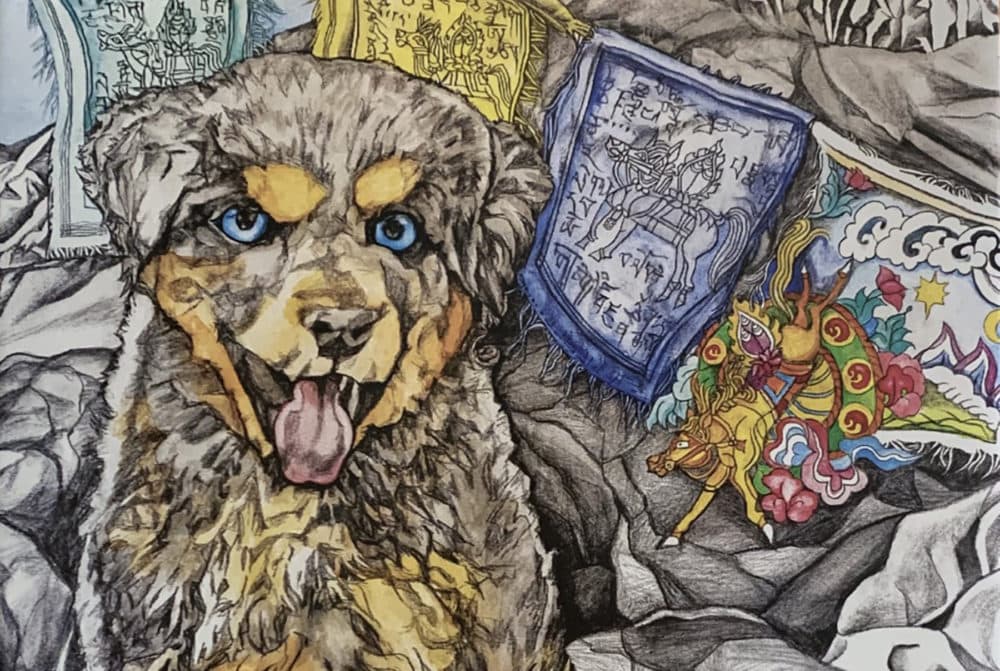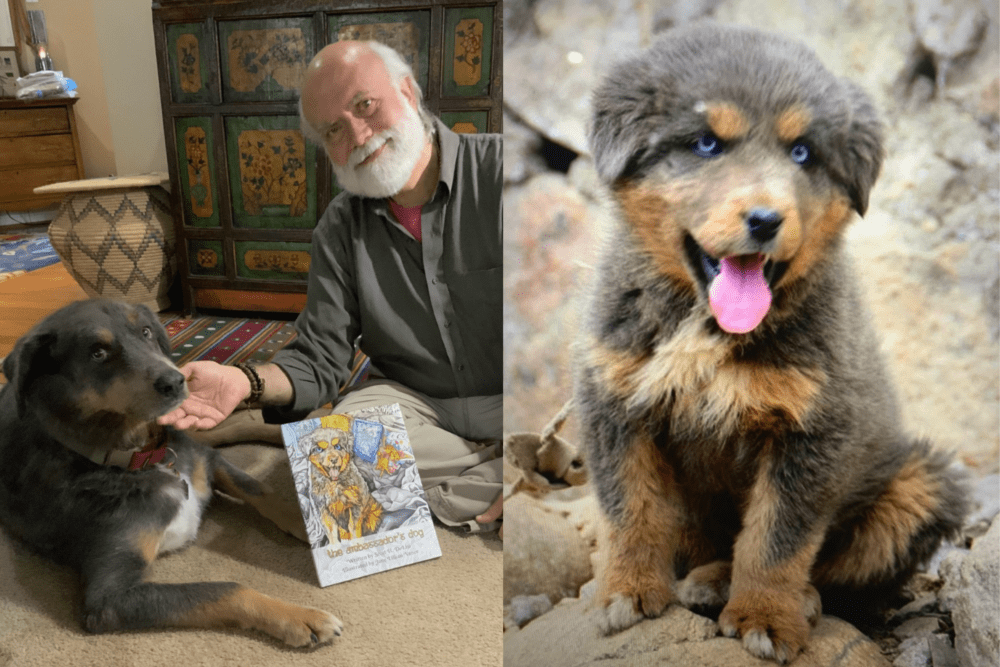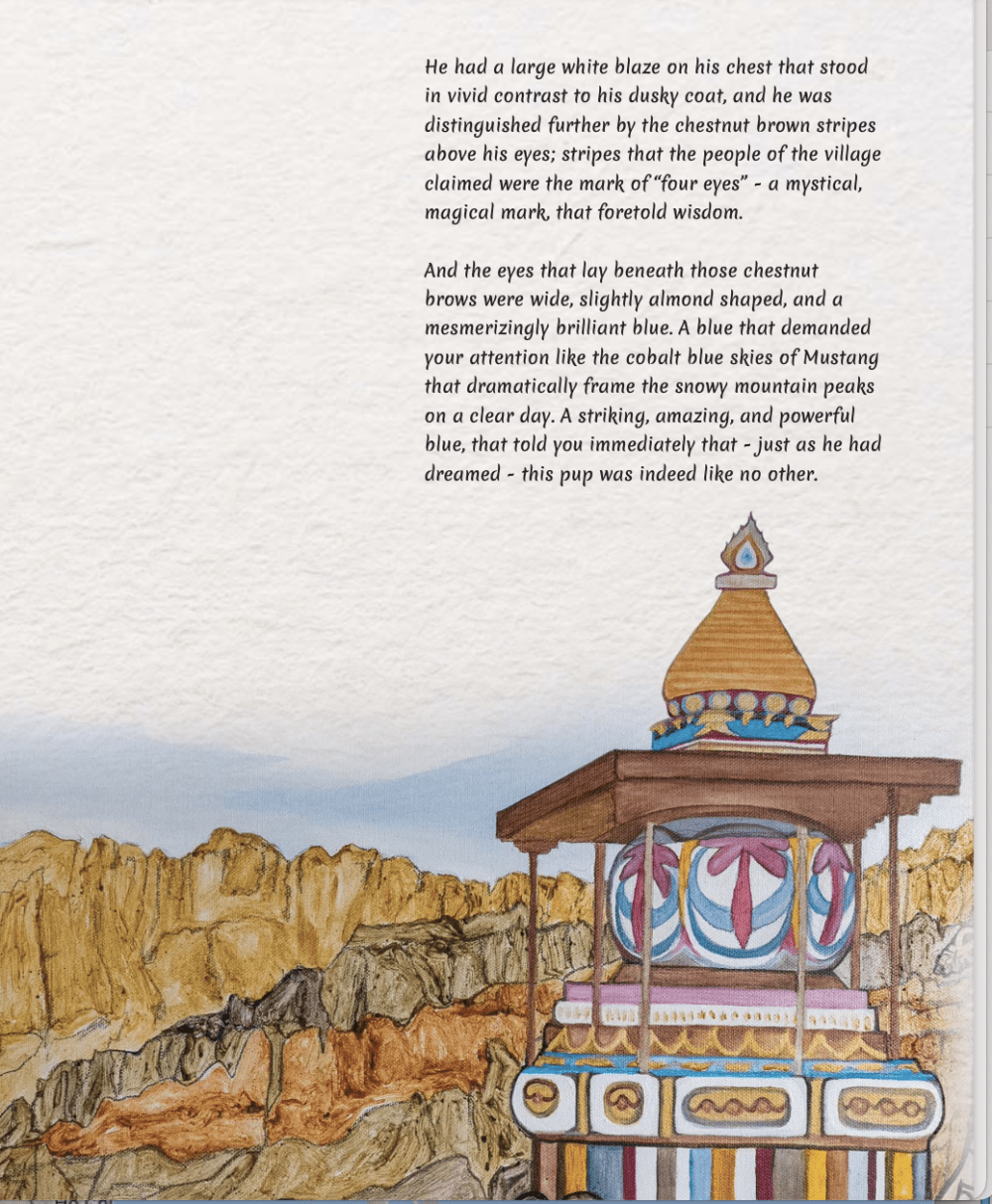Advertisement
The Serendipitous Story Of How A Stray Dog Changed A Former U.S. Ambassador's Life

High up in the Himalayas of Nepal, a puppy without a name or family unexpectedly inhabited the heart of a U.S. ambassador.
Scott DeLisi, who was at the time the U.S. ambassador to Nepal, crossed paths with a small, bright-eyed pureblood Tibetan mastiff. What happened at that moment is the subject of "The Ambassador's Dog," a book he's written for children and adults.
DeLisi was several days into a group trek through what was once an ancient kingdom on the Tibetan plateau. At about 12,000 feet high, the group paused before finishing the final ascent up to the ancient monastery of Lo Gekar.
Looking hillside toward the small village of Saukre, DeLisi spotted a puppy whose dusty fur camouflaged with the color of the Earth in the Mustang region of Nepal.
“It's as if the dust that was always being blown in the wind had embedded itself into this puppy's coat,” he says.

But DeLisi could clearly see the dog — all because of his mesmerizing blue eyes.
The breed, common for the area, are the dogs Marco Polo encountered on his trip to China, DeLisi says.
DeLisi vividly remembers the puppy, who he soon named Lo Khyi, calling out and speaking to him. The dog summoned DeLisi to a perch by calling him “dai,” which means older brother.
“That pup jumped onto my lap and he licked my hands. And then he put his paws on my shoulder and he licked me on the cheek and he looked me in the eye and he said, ‘Dai, you do not know this, but I'm your dog,’ ” DeLisi says. “I said, ‘You may be right.’ ”
DeLisi understands many might not understand how a dog spoke to him — even his own family debates him on the occurrence.
“But I have to remind them that [dogs] do speak. We just have to know how to listen,” he says. “And maybe if there's one thing I've learned over the years as a diplomat, that ability to listen, making the effort to hear what is truly being said and to embrace what you are experiencing, that's part of the key. The puppy spoke to me.”
Advertisement
As DeLisi talked with the dog, a member of his staff came up to him, asking what was going on. The staff member reminded the ambassador he was up 12,000 feet in thin air and said the puppy wasn’t speaking to him.
“And I had to explain very gently to this young man. I said, ‘Son, shut up. I'm having a good conversation with the dog,’ ” he says.
With other tasks ahead of the group, they had to move on. But he says as the group descended back through the village again, the puppy was sitting there, waiting for DeLisi’s return.
DeLisi soon learned that a young boy had found the tiny puppy, shivering and near death, either abandoned or lost from its litter. The boy took him back to the village where the community fed the dog tsampa, a barley porridge.
Nourished, the puppy was free to play and roam the village, but never truly belonged to one person. DeLisi asked the village’s de facto mayor at the time whether the dog was for sale.
“He looked at me and he said, ‘Excellency, you must understand the word for dog is khyi, which is also the word for happiness. So we do not sell them. We give them as gifts,’ ” DeLisi recalls.
As a gift in return, DeLisi gave him all the rupees he had in his pocket, maybe $39 worth, he says. The dog, placed in his arms, looked up at DeLisi and reminded him once more that the two belonged together, he says, “and the rest is history.”
To document the extraordinary experience, DeLisi tapped illustrator Jane Lillian Vance to help tell the story in “The Ambassador’s Dog.” Vance had traveled to Nepal before and used her trip to guide the book’s art.
She took in the vibrant sights around her — black spiral fossilized ammonites, sea buckthorn berries, cobalt blue poppies and a plethora of colorful rocks, she says.
“I found six colors of rock, which I brought back with me to Virginia and pulverized into silt and mixed with clear, transparent oil paint like clear toothpaste,” she says, which she used to paint the scenery within the pages of “The Ambassador's Dog.”
DeLisi, who has the original “vibrant” illustrations, says the connection to the Earth within these paintings makes them come alive. He can feel the texture of the grain when touching the image.
“Those paintings become the Braille of the Himalayas, which you can touch and read here,” Vance says.
“The Ambassador's Dog” serves as a work of art — a telling of a story that goes beyond one man finding a stray dog. DeLisi found purpose and learned lessons through the experience.
In his years as a diplomat, he says he discovered that setting aside preconceived notions and being open to hearing what others have to say was “always more effective than if I went in with just a set of talking points and a very narrow perspective on where we were going to go in the conversation.”
Finding and being open to listening to Lo Khyi, he says, actively reinforced those notions.
Now he can take a tiny bit of Nepal’s beauty with him wherever he goes, with Lo Khyi by his side and his book in arm.
“Nepal, for many people, it's that Shangri-La of legend. There was something magical and mystical about the country,” he says. “And I think that this is a little bit of a tribute to a country that was very special to both of us as we made our own journeys through life.”
Book Excerpt: 'The Ambassador's Dog'
By Scott DeLisi
The people of the village recognized that this handsome blue-gray puppy had a wandering spirit. And, although the people were kind, the puppy sensed that none of them were the family of which he had dreamed. And so he waited. And every day he gazed down the trail that led back to Tsarang and then to a world beyond the plateau.
Karchung had never been beyond the village of Tsarang. Neither had his parents. Nor had most of the people of the village. They were content with their lives in the mountains.

The chickens, the goats, and the donkeys the pup met had never left the mountains either. They had no desire to do so. They too were content with their lives high on the plateau and with their homes in Saukre. But the puppy - the bhote kukur born in the heart of those mountains - knew that his future lay down the trail and beyond. And so, he waited. He knew his dreams would find him and he would find his dreams.
The puppy waited quietly. He waited with dignity. Calmly. Sure that his future lay down the path he watched so intently every day.
The people of Saukre worried that the restless spirit in the puppy would lead him to follow some call only he heard and take him far away from them. So they used a khata, a ceremonial silk blessing scarf, to tie the puppy to a metal rod pounded into the ground on the edge of the trail. But the pup did not mind. He sat. He waited. He watched.
The days passed. Then, one morning, when the pup awoke, the air around him was alive with energy. Karchung did not feel it. The chickens scratching in the dirt did not feel it. The goats wandering through the lanes did not feel it. But the puppy felt it, and his heart raced.
He gobbled down his tsampa and then went out into the day. The worst of the winter chills were gone but a fog still shrouded Saukre early that April morning. The blue-gray pup was almost invisible, blending into the drifting wisps of mist as he raced for his perch overlooking the trail. Karchung knew where the pup was bound and followed along behind. As he had every day for the past week, he tied the pup to the metal rod. The pup did not mind. He sat on his rock, looked down the trail, and waited. The sun rose higher and the mists gave way to a blue sky that matched the puppy’s eyes. The village had come alive as the morning passed. Everyone was in motion. Except the pup. He still waited.
At ten o’clock, people in the village stopped for tea. But the pup waited. Every nerve was tingling. He sat so straight. So strong. So handsome. And he waited. Suddenly, the pup sat even straighter, if such a thing was possible. There. In the distance. People were moving. They came closer and closer and closer. In front was a man. A man in a white shirt wearing a blue cap.
His white beard spoke of the passage of years, but the fact that he hiked in these high mountain passes told the pup that his spirit was strong. The man’s eyes were kind and his voice gentle. The puppy knew that this was his man. This was why he had waited. He knew it, even if the man did not.
The pup mustered all the dignity that a five-week-old puppy could muster. He sat still. But his heart raced. He met the man’s eyes and held them and, for the first time, the puppy spoke.”
Excerpted from "The Ambassador's Dog" by Scott DeLisi. Copyright © 2020 by Scott DeLisi. Republished with permission of DeLisi.
Tinku Ray produced and edited this interview for broadcast. Serena McMahon adapted it for the web.
This segment aired on March 15, 2021.

